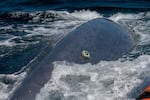Up to now, satellite tags have allowed researchers to track whales for thousands of miles. But location was just about the only information they could provide.

An advanced dive behavior tag. Data recorded by the tag can provide a view of whale behavior that has not been possible before.
Craig Hayslip, Oregon State University, under permit from NOAA/NMFS
The new tags, unveiled in the Journal Ecology and Evolution this month, provide much more detail.
For example, professor Bruce Mate said they show sperm whales diving all the way to the sea floor, almost a mile deep, and being submerged for one-and-a-quarter hours, “This tag actually has three accelerometers on it. So that you can tell as the animal swims along, when it makes a lunge forward to grab a squid. Is it going up to the left, or down to the right."
"And you can tell how many times it attempts to feed on things during each dive," said Mate.
That sheds light on how much energy a whale spends looking for food and which fishing areas are most productive.
The next generation of tag is already being designed. It should be able to download information remotely, so researchers don’t have to travel to find it.

This graphic shows the travel and feeding lunges of a whale along the southern California coast.
Oregon State University
